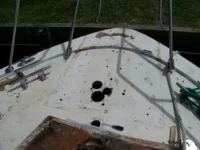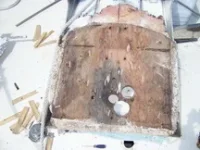Attached are Photos of the deck and underside of the pulpit and which show the location of the screw penetrations between the plywood pad and the deck. The hull penetrations are circled with an orange marker and the pulpit penetrations marked with orange tabs.
A sawzall with a 12” blade was able to cut the screws around the perimeter of the pulpit but could not reach the screws near the centerline of the pulpit. There was no adhesive holding the pulpit plywood pad to the deck, only the screws. There was a bead of sealant around the perimeter of the pulpit which no longer prevented the movement of water under the pulpit. Nor was the plywood sealed or painted, best I can tell. It was about 20% rotted, but still served its purpose of supporting the pulpit. The pad consists of 2 pieces of plywood screwed and glued together, then screwed to the deck. The top of the plywood was covered with a thick coat of polyester resin paste and the pulpit then set over the plywood pad and bolted to the deck. The pulpit bolts were backed with 3/8 thick aluminum plates which showed fairly significant corrosion on their topside. There was a lot of white powder and pitting of the aluminum on the top. None of this was readily apparent from the underside before they were removed.
The reason for all this work removing the pulpit, was not the deterioration of the plywood pad but the balsa coring in the area of the pulpit. The six penetrations for the pulpit bolt and the 5 penetrations for the windlass and its bolts were not sealed and there was fairly significant deterioration of the balsa coring around those penetrations, to the extent that some of the nuts and washers for those bolts were pulling up into the deck.
The deterioration spread to the port deck cleat. I removed it and noted that while there was sealant around the bolts, the balsa around 2 of the 4 bolts was quite wet.
Regards,
Vincent
Lilly Marie 43 DC 1983



